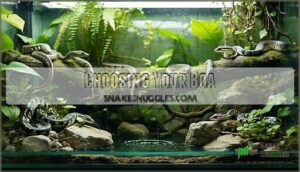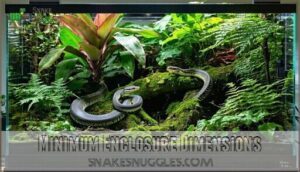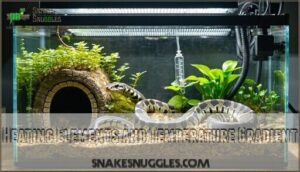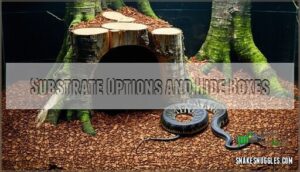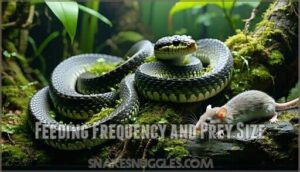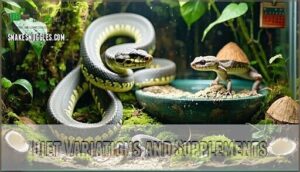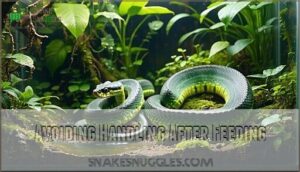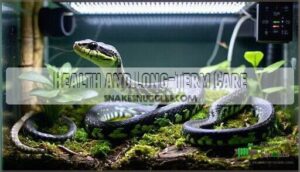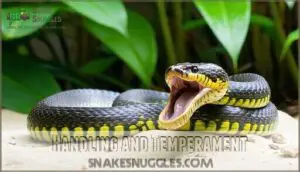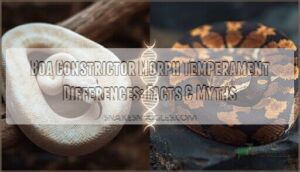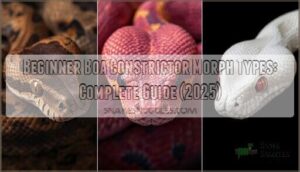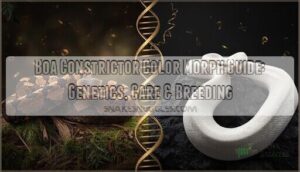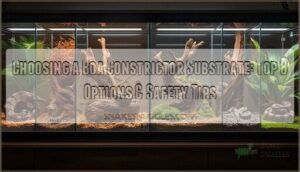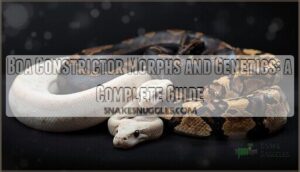This site is supported by our readers. We may earn a commission, at no cost to you, if you purchase through links.
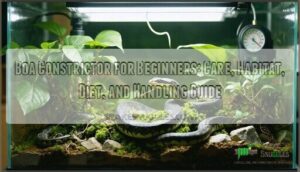
These snakes are non-venomous, grow between 6–10 feet long, and live for 20+ years with proper care.
They need a secure enclosure that provides warmth (80–90°F gradient), moderate humidity (50–70%), and hiding spots to feel safe.
Feeding them pre-killed rodents every 7–14 days is straightforward, but avoid handling them right after meals—they get cranky!
While generally docile, they can feel stressed, so approach handling with patience.
With the right setup and attention, a boa is a rewarding companion.
Curious about dwarf boas? Keep reading!
Table Of Contents
- Key Takeaways
- Boa Constrictor Basics
- Choosing Your Boa
- Boa Constrictor Housing
- Feeding and Nutrition
- Health and Long-Term Care
- Handling and Temperament
- Boa Constrictor Costs
- Frequently Asked Questions (FAQs)
- Are boas high maintenance?
- What are the friendliest boas?
- Do boa constrictors like to be handled?
- What are the different types of boa constrictors?
- Are boa constrictors a good pet snake?
- Can boa constrictors be handled?
- Do boa constrictors climb?
- Should you raise a boa constrictor?
- How do you care for a boa constrictor?
- Are boa constrictors beginner friendly?
- Conclusion
Key Takeaways
- Set up a secure enclosure with a temperature gradient (80–90°F) and moderate humidity (50–70%) to keep your boa healthy and stress-free.
- Feed pre-killed rodents every 7–14 days, matching prey size to the snake’s widest part, and don’t handle them right after meals to avoid regurgitation and stress.
- Handle your boa regularly but gently to build trust, support their body evenly and watch for stress signs like hissing or hiding.
- Boa constrictors are a long-term commitment; they can live over 20 years and grow up to 10 feet, so prepare for steady care and enclosure upgrades.
Boa Constrictor Basics
Boa constrictors, scientifically known as Boa constrictor imperator or Boa constrictor constrictor, are large, non-venomous snakes native to the Americas.
Boa constrictors, majestic and non-venomous, captivate enthusiasts as long-lived companions native to the vibrant landscapes of the Americas.
They can grow up to 10 feet long and live over 20 years, making them a fascinating yet long-term commitment for beginners, especially due to their potential to live over 20 years.
Scientific Names and Classification
A boa constrictor’s taxonomy is straightforward yet fascinating.
The species splits into two main subspecies: Boa constrictor constrictor and Boa constrictor imperator.
These snakes show variations in size, pattern, and habitat, shaped by genetic lineages.
Subspecies identification is key when selecting your boa, as each offers unique traits.
It’s like picking between cousins with distinct family quirks!
The process of choosing a boa is simplified by understanding these variations.
Adult Size and Life Expectancy
Ranging from 8 to 10 feet in adult size, boas reach impressive lengths, often outgrowing standard enclosures.
With a potential 20-year lifespan (sometimes 30 or more), their growth rate depends on care.
Size variations arise between males and females, with females often larger, and as they mature, they require proper handling and enclosure upgrades to prevent challenges.
Enclosure upgrades and proper handling prevent challenges as they mature into hefty, long-term companions requiring commitment.
Native Habitat and Distribution
Ever wonder where Boa constrictors thrive? Native to tropical environments, these snakes inhabit forests, savannas, and wetlands throughout Central and South America.
With geographic variations like the Central American boa and Colombian redtail boa, they adapt to different ecosystems.
Unfortunately, habitat loss threatens their survival, despite their vital ecosystem roles. Protecting tropical climates helps maintain their conservation status remains stable, which is crucial for the ecosystem.
Choosing Your Boa
Choosing the right boa constrictor means considering factors like size, temperament, and care needs. Focus on beginner-friendly species, as they’re often easier to handle and maintain in captivity.
Common Boa Species for Beginners
If you’re new to boa constrictor care, certain snake species are perfect for beginners.
Boa imperator, like Colombian boas, are hardy and forgiving of small mistakes.
Dwarf boas, with their smaller size, are easier to manage.
Opt for captive-bred boas for better health and tame behavior.
Boa morphs, offering stunning patterns, add excitement for first-time owners.
Red-Tail Boa Considerations
When considering a redtail boa, be ready for its size and temperament variations. Despite their calm reputation, they need proper red-tail care.
Beginner suitability improves with consistent handling. Morph availability makes them attractive for collectors, but locale differences impact behavior.
Here’s why they’re great for beginners:
- Docile temperament
- Adaptable care needs
- Stunning morphs
- Manageable size
- Longevity
Dwarf Boa Species Overview
If you’re drawn to smaller snakes, dwarf boas are a perfect beginner boa option.
With boa size averaging 4-6 feet, they’re compact compared to their larger relatives.
Their calmer boa temperament and simpler housing needs make boa care more manageable.
Plus, their conservation status benefits from captive breeding.
For Dwarf Boa ID, check unique colorations typical of these gentle snakes.
Boa Constrictor Housing
Housing your boa constrictor properly is essential to its health and well-being, so you’ll need a spacious enclosure that mimics its natural environment.
A spacious, naturalistic enclosure is the key to keeping your boa healthy, happy, and thriving for years to come.
By providing enough room, the right temperatures, and proper humidity, you’ll help your boa thrive for many years, which is crucial for its overall well-being.
Minimum Enclosure Dimensions
Providing proper space per snake is essential for boa constrictor care. Minimum enclosure dimensions depend on size:
- Juveniles: 3’L x 2’W x 2’H.
- Adults under 7′: 6’L x 3’W x 3’H.
- Larger adults: 8’L x 3’W x 3’H.
Use safe materials and secure locks.
Add vertical space and enrichment for climbing.
Tailor your boa setup thoughtfully!
Heating Elements and Temperature Gradient
Now that you know the right enclosure size, keeping it cozy for your boa is key. Use UTH placement for belly warmth, ceramic emitters for steady heat, and basking lamps for hot spots.
Avoid heat rocks—they’re unsafe. Monitor temperatures daily to maintain a gradient.
Maintaining the correct humidity is also important, and you can achieve this with appropriate humid hides.
Here’s a quick guide:
| Heating Method | Purpose |
|---|---|
| UTH placement | Belly heat |
| Ceramic emitters | Continuous heating |
Humidity Control and Maintenance
Maintaining proper humidity is essential for boa care. Use a hygrometer to monitor 60-75% humidity in your boa enclosure.
Boost levels using misting techniques and choose substrates like dampened sphagnum moss. Shedding problems? Increase humidity to 75%. Keep adequate ventilation to prevent mold.
Accurate readings require a reliable boa hygrometer. Pro tip: curious boas often climb water bowls, so make sure they’re secure!
- Humidity Monitoring: Use a hygrometer for precision.
- Misting Techniques: Spray water directly or use a humidifier.
- Substrate Choice: Opt for moisture-retaining options like sphagnum moss.
Substrate Options and Hide Boxes
Your boa’s substrate should maintain humidity while being easy to clean. Cypress mulch is great for burrowing behavior and boosting enclosure aesthetics.
Avoid cedar; it’s toxic. Add a humid hide box with soft, damp hide material to mimic natural shelters.
Spot-clean boa substrate weekly and deep-clean monthly to prevent odor. Many pet owners buy boa supplies online.
Keeping snake substrate options varied guarantees health and comfort. Your boa needs a well-designed environment, so consider boa substrate when setting up its enclosure.
Feeding and Nutrition
Feeding your boa constrictor properly is key to keeping it healthy and growing at a steady pace.
You’ll need to match the prey size to your snake’s body width and stick to a schedule that varies with its age and size.
Feeding Frequency and Prey Size
Your boa’s feeding schedule depends on its size.
Juveniles eat smaller snake prey weekly, while adults thrive on adult portions like rats every 3-4 weeks.
To maintain boa health, remember that frozen prey is safest and vital for health.
Stick to feeder prey that matches the boa’s broadest body part to prevent regurgitation risks and obesity.
Boa feeding promotes steady growth; remember to avoid handling for a day after meals for comfort.
Diet Variations and Supplements
A varied diet keeps your boa healthy—rotate feeder prey like rats, mice, and chicks.
Snake prey should match the thickest part of your boa’s body to avoid feeding problems or obesity.
Snake feeding doesn’t require supplements unless there’s a deficiency, but light calcium dusting helps.
During brumation, adjust the diet by offering smaller, less frequent meals.
Avoiding Handling After Feeding
After a meal, your boa needs time to digest peacefully.
Handling too soon can trigger regurgitation—a messy, stressful event for both of you.
Watch their behavior for handling cues, like calm movements, and avoid handling during their feeding response phase, when digestion is active.
Stress reduction after feeding guarantees your boa stays healthy, relaxed, and comfortable.
Health and Long-Term Care
Keeping your boa constrictor healthy requires attention to common issues like respiratory infections and a solid understanding of their natural habits.
With proper care, including regular health checks and adjustments for seasonal changes, your snake can thrive for decades.
Common Health Issues and Signs
Recognizing symptoms early is key to boa health. Watch for respiratory infections like wheezing, or signs of inclusion body disease such as regurgitation and "stargazing."
Scale rot and blister disease often stem from poor hygiene. Keep an eye out for cloudy eyes, pink blisters, or lethargy.
Addressing boa respiratory infections promptly is essential for their well-being. Healthy snakes stay alert, shed cleanly, and avoid snake diseases with proper care.
Monitoring and Maintaining Health
Keep your snake healthy by watching for shedding problems, weight gain, or lethargy.
Maintain proper boa temperature and humidity to avoid stress and encourage natural shedding.
Quarantine new boas to prevent disease spread.
Boa health issues, like prolapsed hemipenes, demand a vet visit.
Regular boa handling helps recognize illness early, ensuring your snake thrives in its habitat.
Seasonal Fasting and Brumation
Think your boa’s skipping meals? Seasonal fasting happens during winter, mirroring nature’s rhythm. Brumation triggers a slowdown in activity and appetite, influenced by temperature changes.
Keep temperatures stable to avoid health issues like respiratory infections. After brumation, wait before feeding—digestion takes time.
- Let them skip meals: It’s natural.
- Watch their shedding: Healthy boas shed during seasonal shifts.
- Moderate temperatures: Prevent cold stress.
Handling and Temperament
Handling your boa constrictor correctly helps build trust, making it more comfortable and calm over time. Regular, gentle interactions are key to developing a docile and manageable pet.
Taming and Handling Techniques
To encourage your boa constrictor’s docile behavior, start with consistent handling.
Use secure grip techniques—one hand near the head, another supporting the body.
Gradually increase handling time while reading behavior; avoid sudden movements to reduce stress.
Regular practice helps with bite prevention and turns snake handling into a rewarding experience for both you and your boa.
Recognizing and Managing Stress
Snakes get stressed too, and it’s key to spot early signs.
Watch for hissing, hiding more than usual, or refusal to eat.
Stressors can include:
- Overhandling or sudden handling techniques.
- Improper enclosure size or temperature.
- Shedding stress during skin cycles.
- New surroundings needing adjustment time.
- Visible health issues like aggression.
Addressing these helps in stress reduction for a healthier boa.
Snake-Handling Safety Note
Approaching a boa constrictor safely starts with recognizing signs of stress, like hissing or nippy behavior.
Regular handling builds trust, but stick to proper techniques—support the head and body evenly.
Snake bites are rare with calm handling, but children’s safety means supervising interactions.
Always wash hands after touching prey to prevent mistaken bites during snake handling.
Protective gear enhances snake handling safety.
Boa Constrictor Costs
When budgeting for a boa constrictor, you’ll need to factor in both the initial purchase price and ongoing care costs.
From affordable juveniles to pricey morphs, understanding these expenses will help you plan responsibly.
Acquisition Costs and Species Variations
The initial investment for a Boa constrictor depends on factors like morph prices and breeder reputations.
Captive-bred boas, often healthier than wild-caught ones, cost $50-$200.
Rescue boas are cheaper but require caution, while Dwarf species like Dominican boas run $200-$500, and Kenyan sand boas cost $30-$50.
Choose reputable sources to guarantee a docile, healthy snake species!
Ongoing Care and Maintenance Costs
Caring for a boa comes with ongoing costs. Between substrate replacement, food expenses, and heating costs, maintenance isn’t cheap.
Let’s break it down:
| Expense Category | Monthly Cost (USD) | Annual Cost (USD) | Notes |
|---|---|---|---|
| Substrate Replacement | $10-$20 | $120-$240 | Change every few weeks. |
| Food Expenses | $15-$30 | $180-$360 | Size varies with snake age. |
| Heating Costs | $10-$15 | $120-$180 | Essential for temperature needs. |
| Veterinary Care | $50+ per visit | Varies | Plan for health checks. |
Boa constrictors need proper care to thrive, including temperature and humidity to meet their specific requirements. Budget carefully to enjoy boa ownership and ensure you can provide the necessary veterinary care. For more information, visit temperature and humidity guidelines.
Rehoming and Release Considerations
If boa constrictor ownership becomes overwhelming, embrace ethical rehoming through snake rescue options or responsible snake rehoming networks.
Never consider wild release—it’s illegal, harmful to ecosystems, and jeopardizes the snake’s survival.
Instead, prioritize legal implications and find owners skilled in snake ownership responsibilities. A rescue group guarantees the boa’s care aligns with its lifelong needs, maintaining responsible ownership standards.
Frequently Asked Questions (FAQs)
Are boas high maintenance?
Keeping a boa is no walk in the park—they need precise heating, high humidity, spacious enclosures, and careful feeding schedules.
While not impossible, their long lifespans and care requirements demand a committed and informed owner.
What are the friendliest boas?
Colombian red-tail boas are some of the friendliest.
With regular handling, they’re calm, curious, and rarely aggressive.
Their adaptable nature and manageable size make them perfect pets for beginners looking to build confidence with snakes.
Do boa constrictors like to be handled?
Imagine taming a small dragon—boa constrictors, while not cuddly, can grow to enjoy handling.
Regular, gentle interactions from a young age help them stay calm, view you as safe, and rarely show aggression.
What are the different types of boa constrictors?
You’ll find boa constrictors split into types: Boa constrictor constrictor (common boa) and Boa constrictor imperator (Central American boa).
They vary in size, pattern, and temperament, with the imperator being smaller and often preferred by beginners.
Are boa constrictors a good pet snake?
Owning a boa constrictor is like caring for a scaled roommate; they’re low-maintenance yet demand respect.
With proper handling, housing, and feeding, they make calm, fascinating pets, but their long lifespan requires serious commitment.
Can boa constrictors be handled?
Yes, boa constrictors can be handled safely when you’re careful.
Support their head and body, use both hands, and handle them often to build trust.
They’re strong but rarely aggressive with proper care.
Do boa constrictors climb?
Boa constrictors are excellent climbers, especially when young, thanks to their strong muscles and prehensile tails.
Providing sturdy branches or perches in their enclosure mirrors their natural behavior and keeps them active and healthy.
Should you raise a boa constrictor?
Raising a boa constrictor is like adopting a scaled commitment—they’re long-lived, sizable, and need proper care.
If you’re ready for decades of responsibility, secure housing, and regular feeding, they can make fascinating, low-maintenance pets.
How do you care for a boa constrictor?
Caring for a boa constrictor means providing a secure, escape-proof enclosure, maintaining proper heat and humidity, feeding appropriately sized prey.
Handling them regularly for tameness is also crucial, as it helps in their development and interaction with their owner.
Monitor their health, and prepare for a long-term commitment.
Are boa constrictors beginner friendly?
While boa constrictors can work for beginners, they’re not low-maintenance.
These snakes require sizable enclosures, regular handling, and specialized care.
If you’re prepared for their long lifespan and large size, they’re manageable and rewarding.
Conclusion
Caring for a boa constrictor can be like crafting the perfect recipe—attention to detail is key.
With their docile nature and straightforward needs, a boa constrictor for beginners offers a rewarding experience when provided with proper housing, warmth, and nutrition.
Keep them stress-free, handle with patience, and guarantee consistent care to enjoy years of companionship.
Whether you’re drawn to a dwarf boa or a classic red-tail, these snakes can thrive with your dedication, making them fascinating pets for the responsible reptile enthusiast.
- https://www.reptifiles.com/wild-caught-vs-captive-bred-reptiles/
- https://reptifiles.com/boa-constrictor-care/boa-constrictor-temperatures/
- https://familysnake.com/guides/mastering-the-art-of-temperature-control-in-your-snakes-habitat/
- https://www.youtube.com/watch?v=scycL5yGjZg
- https://odorpatrol.tumblr.com/boaconstrictorhusbandry


